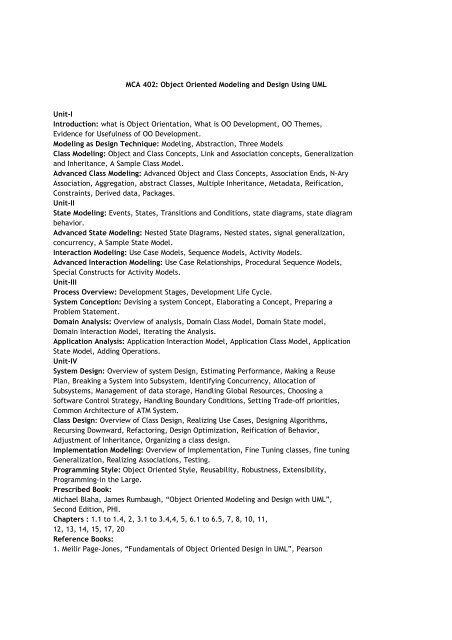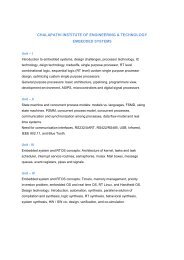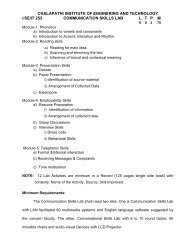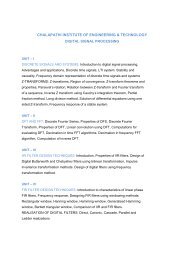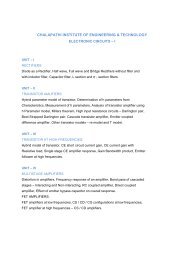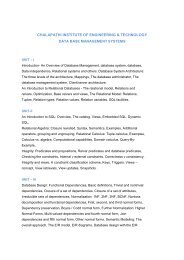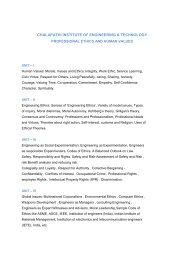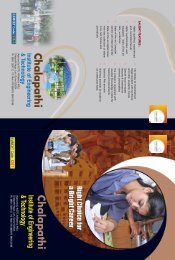Object Oriented Modeling and Design Using UML - chalapathi ...
Object Oriented Modeling and Design Using UML - chalapathi ...
Object Oriented Modeling and Design Using UML - chalapathi ...
You also want an ePaper? Increase the reach of your titles
YUMPU automatically turns print PDFs into web optimized ePapers that Google loves.
MCA 402: <strong>Object</strong> <strong>Oriented</strong> <strong>Modeling</strong> <strong>and</strong> <strong>Design</strong> <strong>Using</strong> <strong>UML</strong><br />
Unit-I<br />
Introduction: what is <strong>Object</strong> Orientation, What is OO Development, OO Themes,<br />
Evidence for Usefulness of OO Development.<br />
<strong>Modeling</strong> as <strong>Design</strong> Technique: <strong>Modeling</strong>, Abstraction, Three Models<br />
Class <strong>Modeling</strong>: <strong>Object</strong> <strong>and</strong> Class Concepts, Link <strong>and</strong> Association concepts, Generalization<br />
<strong>and</strong> Inheritance, A Sample Class Model.<br />
Advanced Class <strong>Modeling</strong>: Advanced <strong>Object</strong> <strong>and</strong> Class Concepts, Association Ends, N-Ary<br />
Association, Aggregation, abstract Classes, Multiple Inheritance, Metadata, Reification,<br />
Constraints, Derived data, Packages.<br />
Unit-II<br />
State <strong>Modeling</strong>: Events, States, Transitions <strong>and</strong> Conditions, state diagrams, state diagram<br />
behavior.<br />
Advanced State <strong>Modeling</strong>: Nested State Diagrams, Nested states, signal generalization,<br />
concurrency, A Sample State Model.<br />
Interaction <strong>Modeling</strong>: Use Case Models, Sequence Models, Activity Models.<br />
Advanced Interaction <strong>Modeling</strong>: Use Case Relationships, Procedural Sequence Models,<br />
Special Constructs for Activity Models.<br />
Unit-III<br />
Process Overview: Development Stages, Development Life Cycle.<br />
System Conception: Devising a system Concept, Elaborating a Concept, Preparing a<br />
Problem Statement.<br />
Domain Analysis: Overview of analysis, Domain Class Model, Domain State model,<br />
Domain Interaction Model, Iterating the Analysis.<br />
Application Analysis: Application Interaction Model, Application Class Model, Application<br />
State Model, Adding Operations.<br />
Unit-IV<br />
System <strong>Design</strong>: Overview of system <strong>Design</strong>, Estimating Performance, Making a Reuse<br />
Plan, Breaking a System into Subsystem, Identifying Concurrency, Allocation of<br />
Subsystems, Management of data storage, H<strong>and</strong>ling Global Resources, Choosing a<br />
Software Control Strategy, H<strong>and</strong>ling Boundary Conditions, Setting Trade-off priorities,<br />
Common Architecture of ATM System.<br />
Class <strong>Design</strong>: Overview of Class <strong>Design</strong>, Realizing Use Cases, <strong>Design</strong>ing Algorithms,<br />
Recursing Downward, Refactoring, <strong>Design</strong> Optimization, Reification of Behavior,<br />
Adjustment of Inheritance, Organizing a class design.<br />
Implementation <strong>Modeling</strong>: Overview of Implementation, Fine Tuning classes, fine tuning<br />
Generalization, Realizing Associations, Testing.<br />
Programming Style: <strong>Object</strong> <strong>Oriented</strong> Style, Reusability, Robustness, Extensibility,<br />
Programming-in the Large.<br />
Prescribed Book:<br />
Michael Blaha, James Rumbaugh, “<strong>Object</strong> <strong>Oriented</strong> <strong>Modeling</strong> <strong>and</strong> <strong>Design</strong> with <strong>UML</strong>”,<br />
Second Edition, PHI.<br />
Chapters : 1.1 to 1.4, 2, 3.1 to 3.4,4, 5, 6.1 to 6.5, 7, 8, 10, 11,<br />
12, 13, 14, 15, 17, 20<br />
Reference Books:<br />
1. Meilir Page-Jones, “Fundamentals of <strong>Object</strong> <strong>Oriented</strong> <strong>Design</strong> in <strong>UML</strong>”, Pearson
Education (2008).<br />
3. Hans-Erik Eriksson, “<strong>UML</strong>Z Took Kit”, Wiley (2008).<br />
4. Pascal Roques, “<strong>Modeling</strong> Software Systems <strong>Using</strong> <strong>UML</strong>2”, Wiley (2008).<br />
5. Simon Benett, Steve Mc Robb, “<strong>Object</strong> <strong>Oriented</strong> Systems Analysis <strong>and</strong> <strong>Design</strong><br />
using <strong>UML</strong>”, Second Edition, TMH (2007).<br />
6. Mark Priestley, “Practical <strong>Object</strong> <strong>Oriented</strong> <strong>Design</strong> with <strong>UML</strong>”, Second Edition, TMH<br />
(2008).<br />
7. Grady Booch, James Rumbaugh “The Unified <strong>Modeling</strong> Language User Guide”,<br />
Pearson (2008).


